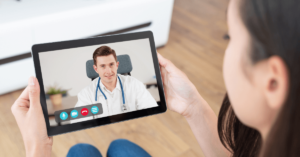Why do we need to debunk these telemedicine myths?
As telemedicine continues to rise in popularity, several telemedicine myths have emerged. The public may be reluctant to accept telemedicine because of inaccurate information. For this reason, many may overlook its many benefits for diagnosing and treating health conditions.
This is unfortunate as it has become an increasingly essential part of the healthcare system. Thus, we need to debunk these telemedicine myths to allow it to reach its full potential. We must discuss telemedicine openly and focus on factual information when debunking these misconceptions.
Here are the telemedicine myths that we’ll debunk today!

1. Telemedicine is just a thing of the pandemic.
When telemedicine first emerged as an answer to the global pandemic, many patients were skeptical about its use. Currently, there are still many telemedicine myths that we need to clarify for doctors who are considering a Telemedicine practice. But telemedicine is more than just a fad or a temporary solution. It has already become an essential tool with lasting effects.
Telemedicine provides the opportunity for healthcare delivery across distances. It increases access to care, particularly in areas with shortages of health workers. Additionally, telemedicine allows for easier and faster access to preventive health services and mental health support. Finally, it reduces wait times, boosts convenience, and saves money in the long run. From diagnosis to treatments, telemedicine is proving to be here to stay beyond the pandemic.

2. Telemedicine isn’t secure.
Unfortunately, with telemedicine come many telemedicine security concerns. Specifically, the question of how to keep data secure when transmitted virtually. While you should not ignore telemedicine myths about potential cybersecurity, the truth is they can be safe when done properly.
There are essential cybersecurity measures that medical organizations should take. It includes using strong passwords and encryption to protect data and only allowing authorized people to access teleconferencing systems. Providers can also use advanced encryption techniques and other technological measures. These will keep data secure from external parties who have malicious intent.
When medical practices invest carefully in cybersecurity, they can ensure they take advantage of telemedicine. All while also protecting their patients’ privacy accordingly.
Read here to know how VMAs can Improve your Telemedicine Practice

3. Telemedicine is only for those in remote areas.
Up to this day, there are telemedicine myths that we need to debunk. One of these is the belief that it is only for those living in remote areas. This myth might be perpetuated by those who think telemedicine isn’t helpful except for patients living isolated lives.
The truth is telemedicine has a wide range of uses. It can help anyone with an internet connection if they choose not to leave the house due to traffic. It can also serve those who want speedy access to a specialist. Most importantly, it extends care to patients with chronic illness. Telemedicine isn’t just limited to rural areas. Physicians like you can use it across urban, suburban, rural, and remote locations.

4. Telemedicine ruins doctor and patient relationships.
Contrary to common telemedicine myths, telemedicine does not ruin the doctor and patient relationship. In fact, telemedicine can improve the quality of this relationship by bringing convenience for both parties. Additionally, it helps strengthen relationships between doctors and patients by allowing for more reliable communication and more convenient care delivery.
It also enables the immediate exchange of clinical data, quick access to physicians, and enhanced collaboration between providers. All of these lead to better overall patient outcomes. By helping to debunk this telemedicine myth, we can ensure patients and doctors alike get the most out of telemedicine.

5. Compensation might be a problem.
One of the telemedicine myths we need to debunk is related to compensation. For telemedicine to grow, medical professionals offering telehealth must receive adequate compensation. Various regulations and rules are in place to protect telemedicine providers by ensuring they receive fair reimbursement for their services.
In some states, telemedicine providers have equal or near-equal reimbursement rates with in-person visits. This is to help dispel this myth and allow medical professionals to provide better care remotely without the worry of inadequate compensation. Accordingly, understanding telemedicine regulations and payment guidelines can help set providers up for success.

6. Telemedicine is not effective.
We’ve all heard the telemedicine myths like telemedicine is not efficient. But it’s time to put these myths to rest. Telemedicine has proven to be effective primarily due to its convenience. Patients can access medical care remotely by video or telephone conference. As a result, they would often receive a diagnosis as accurately as they would in an office visit.
With telemedicine, physicians can also receive more detailed vital data from patients remotely and even prescribe medication in some cases. Its convenience makes seeking medical attention easier and faster for the patients. Consequently, doctors can help more patients with this type of method. Thus, undeniably, telemedicine is highly effective!

7. Telemedicine provides a lower-quality care.
Unfortunately, one telemedicine myth that persists today is that telemedicine is not effective. While telemedicine may not be suitable for every situation, evidence shows it can improve both patient care quality and access to care. The truth is telemedicine can save time and money while providing an invaluable service to those who need healthcare promptly.
Further, telemedicine allows for an extra layer of convenience and safety. Patients will have access to prescription renewals, diagnoses, follow-ups, and other medical treatments without worrying about physical travel. Additionally, it can help clinicians to discuss health issues more deeply with their patients. This is due to their flexible scheduling options compared to in-person appointments. This kind of thorough communication is invaluable from a healthcare perspective as it helps doctors diagnose problems quicker, leading to better overall outcomes for the patient.
Let’s prove them wrong!
Core Virtual Solutions aim to help your Telemedicine practice thrive. So, we offer you ten types of Virtual Medical Assistants (VMAs) who are all thoroughly vetted. This is to ensure that we only bring you HIPAA-compliant and experienced VMAs. Book a free and quick discovery call with us to discuss more of this!








